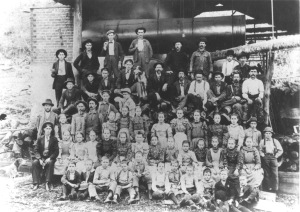Working in textile mills before the mid-1900s was rife with danger. The entire mill line was exposed to hundreds of fast-moving parts—belts, spindles, shuttles–that could easily snag you if you were not paying attention. It was not uncommon for workers in mills to have accidents, such as getting a limb caught in a machine, which would leave them injured for life. Working in a mill could also result in chronic illness, as the lint in the air that workers breathed could accumulate in the lungs, causing respiratory problems.
Adults were not the only ones to face the hazards of mill life. Unlike today, when you have to be at least a teenager to go to work, children were permitted and even encouraged to work in textile plants so that they could help their families financially. These children, due to their small size, would be tasked with climbing on the machinery to reach places that adults could not, allowing them to fix any breakdowns or tangling of textile lines. That also meant that, because they were reaching into and climbing on the machines, they were very likely to fall victim to accidents.
Thankfully, as time went on and machinery safety and building architecture improved, so did working conditions. Federal laws began to prohibit children from working until they reached a reasonable age and the health and safety of employees began to receive more attention from authorities. Outside of government intervention, workers also began to band together to form unions that acted to intercede both with employers and with the government to work for improvements such as shorter workdays and fair pay. While the successes of unions varied from time to time and place to place, their work often did lead to reforms that greatly improved life for mill workers.



Leave a Reply